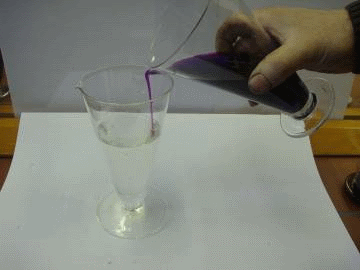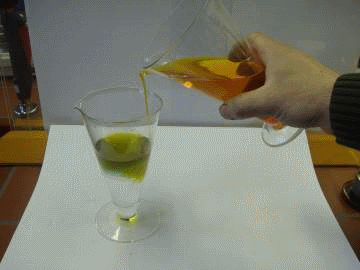






$MnO_4^{-}$ $..$ $\longrightarrow$ $Mn^{2+}$
The oxidation number of (Mn) varies from 7 to 2, the oxidation number of the $O$ atoms doesn't change, in fact the absence of the gas $O_2(g)$ suggests that O atoms have probably been transformed to $H_2O$:
$MnO_4^{-}$ takes $5 e^-$, 4 molecules $H_2O$ are produced!
$MnO_4^{-}$ $+$ $5e^-$ $+$ $..$ $\longrightarrow$ $Mn^{2+}$ $+$ $4H_2O$
The hydrogen atoms which serve to produce the 4 water molecules must come as $H^+$ ions from the added sulfuric acid:
$MnO_4^{-}$ $+$ $5e^-$ $+$ $8H^+$ $\longrightarrow$ $ Mn^{2+}$ $+$ $4H_2O$
Now the complete equation:
$MnO_4^-$ $+$ $5e^-$ $+$ $8H^+$ $\longrightarrow$ $Mn^{2+}$ $+$ $4H_2O$
$Fe^{2+}$ $-$ $e^-$ $\longrightarrow$ $Fe^{3+}$ | $\cdot 5$
 $MnO_4^-$ $+$ $5Fe^{2+}$ $+$ $8H^+$ $\longrightarrow$ $Mn^{2+}$ $+$ $5Fe^{3+}$ $+$ $4H_2O$
$MnO_4^-$ $+$ $5Fe^{2+}$ $+$ $8H^+$ $\longrightarrow$ $Mn^{2+}$ $+$ $5Fe^{3+}$ $+$ $4H_2O$

$Cr_2O_7^{2-}$ $..$ $\longrightarrow$ $2{Cr}^{3+}$
The oxidation number of(Cr_2) varies from $2\cdot 6=12$ to $2\cdot 3=6$, the oxidation number of the $O$ atoms doesn't change, in fact the absence of the gas $O_2(g)$ suggests that O atoms have probably been transformed to $H_2O$:
$Cr_2O_7^{2-}$ takes $6 e^-$, 7 molecules $H_2O$ are produced!
$Cr_2O_7^{2-}$ $+$ $6e^-$ $+$ $..$ $\longrightarrow$ $2Cr^{3+}$ $+$ $7H_2O $
The hydrogen atoms which serve to produce the 7 water molecules must come as $H^+$ ions from the added sulfuric acid:
$Cr_2O_7^{2-}$ $+$ $6e^-$ $+$ $14H^+$ $\longrightarrow$ $2Cr^{3+}$ $+$ $7H_2O$
Now the complete equation:
$Cr_2O_7^{2-}$ $+$ $6e^-$ $+$ $14H^+$ $\longrightarrow$ $2Cr^{3+}$ $+$ $7H_2O$
$Fe^{2+}$ $-$ $e^-$ $\longrightarrow$ $Fe^{3+}$ | $\cdot 6$
 $Cr_2O_7^{2-}$ $+$ $6Fe^{2+}$ $+$ $14H^+$ $\longrightarrow$ $2Cr^{3+}$ $+$ $6Fe^{3+}$ $+$ $7H_2O$
$Cr_2O_7^{2-}$ $+$ $6Fe^{2+}$ $+$ $14H^+$ $\longrightarrow$ $2Cr^{3+}$ $+$ $6Fe^{3+}$ $+$ $7H_2O$

$NO_3^{-}$ $..$ $\longrightarrow$ $NO$
The oxidation number of(N) varies from 5 to 2, the oxidation number of the $O$ atoms doesn't change:
$NO_3^{-}$ takes $3 e^-$, 2 molecules $H_2O$ are produced!
$NO_3^{-}$ $+$ $3e^-$ $+$ $..$ $ \longrightarrow$ $NO(g)$ $+$ $2H_2O $
The hydrogen atoms which serve to produce the 2 water molecules must come as $H^+$ ions from the nitric acid itself:
$NO_3^{-}$ $+$ $3e^-$ $+$ $4H^+$ $\longrightarrow$ $NO(g)$ $+$ $2H_2O$
Now the complete equation:
$NO_3^{-}$ $+$ $3e^-$ $+$ $4H^+$ $\longrightarrow$ $NO(g)$ $+$ $2H_2O$ | $\cdot 2$
$Cu$ $-$ $2e^-$ $\longrightarrow$ $Cu^{2+}$ | $\cdot 3$
 $2NO_3^{-}$ $+$ $3Cu$ $+$ $8H^+$ $\longrightarrow$ $3Cu^{2+}$ $+$ $2NO(g)$ $+$ $4H_2O$
$2NO_3^{-}$ $+$ $3Cu$ $+$ $8H^+$ $\longrightarrow$ $3Cu^{2+}$ $+$ $2NO(g)$ $+$ $4H_2O$
Nitrogen monoxide $NO$ is a colourless gas. Brought into contact with oxygen, it reacts to give the brown gas nitrogen dioxide $NO_2$: $2NO(g)$ $+$ $O_2$ $\longrightarrow$ $2$$NO_2(g)$